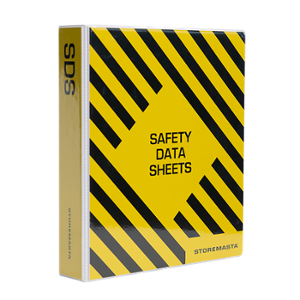Record keeping, administration, and paperwork often get a bad rap — falsely accused of being laborious, time consuming, and something that gets in the way of the real work. But when it comes to managing the risks of hazardous chemicals in the workplace, we know that consistent and efficient record keeping is an essential part of the hazard identification and risk management process (as well as overall compliance). This blog looks at HAZCHEM safety records and explains why they’re an essential part of your risk management program.
Why Do You Need HAZCHEM Safety Data Sheets and other Records?
When managed properly, safety records can bind the entire organisation toward a working safety culture. Good records help you efficiently manage your chemical inventory, enable management transparency, as well as document compliance.
Let’s take a look at each of these HAZCHEM records:
1. Compliance
Many records are mandatory under Australian WHS Regulations and your workplace will not be compliant without them.
Essential records include:
- Safety data sheets for each HAZCHEM product (SDS must be under 5 years old to be current)
- Hazardous Chemical Register
- Hazardous Chemical Manifest
- Emergency Plans
- Employee health monitoring records
- Airborne contaminant levels
- Risk assessments relating to certain high-risk occupations (eg, chemicals used or stored in confined spaces)
- Staff training (eg, emergency drills, high risk occupations)
- Records of equipment testing and tagging
- Usage of prohibited or restricted hazardous chemicals
Essential hazardous substance safety records include safety data sheets, register and manifest of hazardous chemicals, and emergency plans.
2. Transparency
We know that people don’t stay in job roles forever, and good records enable the next person in the job to continue the WHS momentum without having to reinvent the wheel.
Let’s look at the following simple example below.
A hazard has been identified in the flammable liquids store — containers of flammables are being delivered by suppliers and left sitting in the yard for up to 48 hours before being put away. There is no spill protection for the hazardous chemicals and the packages are vulnerable to the weather, theft, and impact damage.
The onsite risk assessment determines that the best way to address the issue is to eliminate the hazard by using a different supplier who calls before arriving at the worksite. Records aren’t considered necessary because this is a quick fix solution.
Now two years later, flammable liquids are still being left in the yard without proper storage after delivery. Another risk assessment is conducted by the new manager who decides to change suppliers to fix the HAZCHEM problem. However, if proper records had been kept, the new manager would have seen that this change is ineffective. The risk management report could have been presented to a WHS committee or management team for tracking and ongoing review, so that the problem was properly resolved.
3. Inventory Management
When you have a reliable record keeping system you can easily track your inventory of hazardous chemicals and dangerous goods — you’ll know exactly what stocks you have on hand, where they are stored, and the age of containers and storage cabinets. Dangerous goods safety is essential for all workplaces, whether you're a sole operator or a large organisation.
Many hazardous chemicals have expiry dates, so inventory records are more effective if you build in automated triggers and flags for when:
- HAZCHEM stocks exceed Manifest and Placarding quantities
- Hazardous substances are close to their use-by-dates
- Gas bottles are getting close to their testing dates
- Chemical stores are due for inspection and integrity testing

Safety record keeping may include integrity testing for hazardous chemical stores.
What Sort of WHS Records Should Be Kept (and How)?
Record management involves more than keeping every piece of paperwork that passes through the organisation. An efficient records system enables you to find the stuff you need, quickly. This is especially important for WHS records, as someone’s life may depend on how fast you can access a Safety Data Sheet or health monitoring report.
Here are a few suggestions for the types of safety records that need to be kept onsite:
1. Purchase Records of Hazardous Chemicals and Storage Equipment
As mentioned earlier, many chemicals have use-by-dates and won’t be safe for use once that has expired. At the same time safety cabinets and storage equipment will degrade with heavy usage (particularly if they are kept outdoors in an extreme climate). Your controls won't be effective in preventing chemical hazards if they aren't maintained properly.
The records you keep should track key purchasing and installation dates.
Many workplaces approach record keeping by stuffing a pile of invoices into a filing cabinet, or having a computer folder filled with PDF documents that have vague file names. We suggest building an electronic inventory of your chemical stocks and cabinets, taking the time to create an inventory system that summarises purchases and doesn’t rely on a pile of source documents.
2. Site Inspections and Safety Audits for Hazardous Chemicals
How can you turn 5 years’ worth of site inspections and safety audits into a meaningful record system? You could incorporate each safety audit into your risk management program, developing an action plan which tracks the control measures you’ve implemented for each hazard. You can then add or delete items as other site inspections are conducted.
3. Incident Reports
Incident reports include reportable workplace accidents and near misses, but could also include things like equipment breakdowns, power outages, or the theft of chemicals. Reviewing incident reports can indicate hazards missed in previous risk assessments. Like safety audits, these can also be incorporated into your risk management program and action plans.
4. Staff Induction and Training
Your staff training records should include the content of each training/induction module, the dates the training was delivered, and attendance records. Many organisations have workers sign individual attendance sheets and keep a copy in their personnel files.
If a worker is involved in an accident or exposure incident with certain hazardous chemicals, you may be required to demonstrate that they were properly supervised and trained to understand the chemical hazards. Effective training records will also have automated triggers for refresher training and competence reviews.
Record Keeping Hazardous Substances with Storemasta
Efficient record keeping can effectively contribute to the safety of your workplace and assist you in maintaining chemical control measures and safety equipment. To simplify this process, we recommend accessing your copy of our easy-to-understand eBook. How to manage the risk of Hazardous Chemicals in the workplace details the risk management process, including important information about WHS documents that can assist with hazardous chemical safety. Grab your copy for free today to learn more.
Joining the team as a Dangerous Goods Storage Consultant, Melissa Hampton became Storemasta's Marketing Manager in late 2021. With extensive knowledge and experience in chemical compliance, Melissa is responsible for leading the Marketing team and helping shape their marketing strategy. In her spare time, you can find Melissa hiking, swimming and enjoying the great outdoors in beautiful north-west Tasmania.


